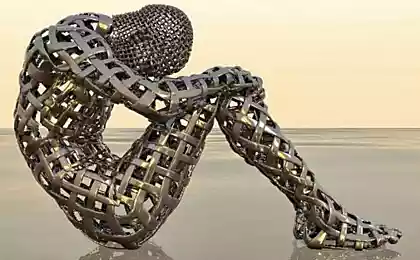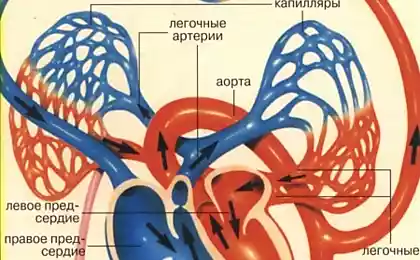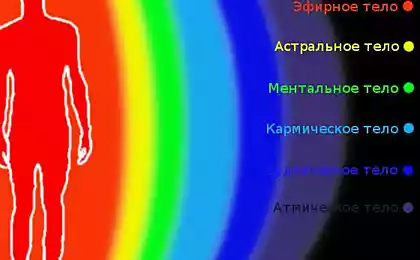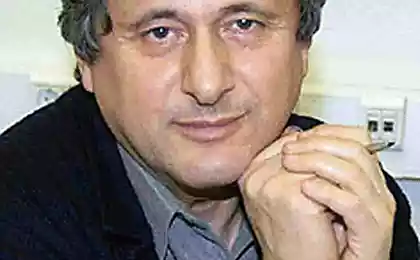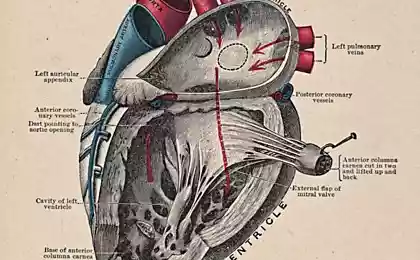238
Interesting facts about the human heart
Did you know that when a choir sings, all its participants synchronize their heartbeat? Here are 24 interesting facts about the heart that will make you look at this most important human organ. The heart is a human motor with many superpowers.
Every day, the heart produces enough energy to drive a truck for 40 kilometers.
In a lifetime, the equivalent of energy allows you to get to the moon and back.
The heart pumps blood to nearly all of the body’s 75 trillion cells.
Only the corneas of the eyes do without blood supply - even scientists did not suspect this interesting fact until recently.
The heart does more work than any other muscle.
Over an average lifespan, the heart will pump nearly 1.5 million barrels of blood — enough to fill 200 train cisterns.
The first heart cell starts beating after 4 weeks.
The blue whale has the largest heart, weighing more than 680 kilograms.
The more educated a person is, the less likely they are to have heart disease.
Despite this, heart disease is still the biggest threat to your health.
Heart disease has been found in mummies as young as 300 years old.
Happiness, lack of stress, exercise, and a healthy diet keep your heart healthy.
The number of heart attacks reaches a maximum on the New Year, as well as in the summer, during a period of extreme heat.
The most likely heart attack is on Monday morning.
The first pacemakers had to be included in the outlet.
Since the heart has its own electrical impulse, it can continue to beat even when separated from the body as long as it has the necessary supply of oxygen.
In 1929, German surgeon Werner Forssmann examined the inside of his heart by inserting a catheter into a vein of his arm. It was the first cardiac sensing and now a common procedure.
On December 3, 1967, Dr. Christian Barnard of South Africa transplanted a human heart into the body of Louis Vashansky. Although the patient lived only 18 days, it is considered the first successful heart transplant.
Take a tennis ball and squeeze it as tightly as possible: this demonstrates the effort of the heart to pump blood.
An interesting fact is that a woman’s heart beats more often than a man’s.
As stated earlier, happiness does lead to heart health, as does laughter. Laughter can speed up the flow of blood through your veins by 20%, as it relaxes the walls of blood vessels.
No one is sure exactly why the heart is historically associated with love (many ancient civilizations associated it with emotion), but some historians attribute it to the Greeks.
The idea of a broken heart actually carries some weight. After overcoming an emotionally traumatic state, your body releases stress hormones into the bloodstream, which can temporarily shake the heart and even mimic the symptoms of a heart attack.
A recent study by Swedish researchers found that while singing the choir, the heart rhythms of all participants synchronized.
Source: lifeglobe.net/
Every day, the heart produces enough energy to drive a truck for 40 kilometers.
In a lifetime, the equivalent of energy allows you to get to the moon and back.
The heart pumps blood to nearly all of the body’s 75 trillion cells.
Only the corneas of the eyes do without blood supply - even scientists did not suspect this interesting fact until recently.
The heart does more work than any other muscle.
Over an average lifespan, the heart will pump nearly 1.5 million barrels of blood — enough to fill 200 train cisterns.
The first heart cell starts beating after 4 weeks.
The blue whale has the largest heart, weighing more than 680 kilograms.
The more educated a person is, the less likely they are to have heart disease.
Despite this, heart disease is still the biggest threat to your health.
Heart disease has been found in mummies as young as 300 years old.
Happiness, lack of stress, exercise, and a healthy diet keep your heart healthy.
The number of heart attacks reaches a maximum on the New Year, as well as in the summer, during a period of extreme heat.
The most likely heart attack is on Monday morning.
The first pacemakers had to be included in the outlet.
Since the heart has its own electrical impulse, it can continue to beat even when separated from the body as long as it has the necessary supply of oxygen.
In 1929, German surgeon Werner Forssmann examined the inside of his heart by inserting a catheter into a vein of his arm. It was the first cardiac sensing and now a common procedure.
On December 3, 1967, Dr. Christian Barnard of South Africa transplanted a human heart into the body of Louis Vashansky. Although the patient lived only 18 days, it is considered the first successful heart transplant.
Take a tennis ball and squeeze it as tightly as possible: this demonstrates the effort of the heart to pump blood.
An interesting fact is that a woman’s heart beats more often than a man’s.
As stated earlier, happiness does lead to heart health, as does laughter. Laughter can speed up the flow of blood through your veins by 20%, as it relaxes the walls of blood vessels.
No one is sure exactly why the heart is historically associated with love (many ancient civilizations associated it with emotion), but some historians attribute it to the Greeks.
The idea of a broken heart actually carries some weight. After overcoming an emotionally traumatic state, your body releases stress hormones into the bloodstream, which can temporarily shake the heart and even mimic the symptoms of a heart attack.
A recent study by Swedish researchers found that while singing the choir, the heart rhythms of all participants synchronized.
Source: lifeglobe.net/


